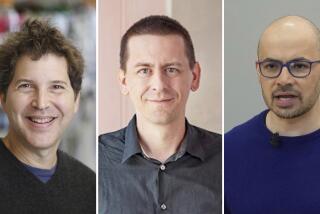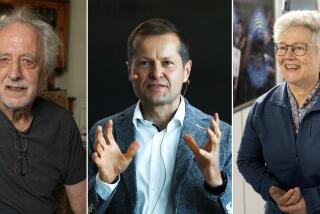David H. Hubel dies at 87; Nobel winner unlocked secrets of sight
- Share via
When neurobiologist David H. Hubel accepted his Nobel Prize in 1981, it had only been a couple of decades since he and his research partner danced in front of an anesthetized cat.
Hubel and Torsten N. Wiesel were measuring electrical activity in particular cells of the cerebral cortex, the brain area that was known to be the seat of vision. But nothing they showed their cats — a dot on a screen, a bright light — seemed to move the dial. In frustration, they did a little dance. They jokingly displayed magazine photos of sexy women — but to no avail.
Over a 25-year collaboration and with a few strokes of serendipity, they eventually broke through — to spectacular effect. With the aid of tiny tungsten electrodes designed by Hubel, they discovered the profoundly elegant neural systems that enable us to see, mapping the complex process down to individual cells. Their insights changed the standard treatment of newborns with eye disorders such as cataracts and strabismus.
Hubel, a professor emeritus at Harvard Medical School, died of kidney failure Sept. 22 in Lincoln, Mass., family members said. He was 87.
He and Wiesel shared the Nobel Prize in physiology or medicine with Caltech neuropsychologist Roger W. Sperry who explored the function of the brain’s hemispheres.
For Hubel, the prize was an exhilarating moment not only in his career but in a long friendship and collaboration with Wiesel, a psychiatrist from Sweden. In his Nobel lecture, he told of grueling nights in the lab as the two painstakingly tried to gauge the activity of individual neurons in the cats and monkeys that were their test animals.
“I knew we were losing traction in an experiment when Torsten began to talk to me in Swedish,” he said. “Usually this was around 3 a.m.”
Sometimes the cells they were studying failed to react even when the animals’ eyes were hit with blasts of light. Other times, the pair got lucky and the audio monitors hooked up to the electrode on a particular cell would start clicking like crazy.
“When we succeed and suddenly can make a cell fire like a machine gun, it can be thrilling — and on a good day the thrills may come every few hours,” Hubel wrote in “Brain and Visual Perception,” a 2004 memoir he co-wrote with Wiesel. “When it comes to sheer fun, our field is hard to beat. We try to keep that a secret.”
One day, they found a cell reacting wildly when a cat viewed a straight line — the edge of a slide that was accidentally jammed in their projector. Testing that cell for nine hours, they were astonished to realize it reacted only to straight lines at exactly the same angle.
This suggested, as their experiments over the years proved, that the cells responsible for vision are exquisitely specialized, with some responding to vertically oriented lines, some to horizontal, others to corners, still others to colors. Through what Hubel called a “scarcely imaginable” array of neural connections, each cell contributes to building an image, which, in an instant, is transmitted to other areas of the brain.
When neuroscientist Eric Kandel, a Nobel laureate in 2000, was told by a fellow scientist that the findings had “limited biological generality,” he had a tart reply.
“You are right — it does not apply to the kidney or the spleen,” Kandel said. “It is much more restricted. It only helps to explain the workings of the mind.”
Born Feb. 27, 1926, in Windsor, Canada, David Hunter Hubel grew up in Montreal. The son of an American chemical engineer, he studied math and physics at McGill University. Although he never took biology, he applied to McGill’s medical school on a whim and, “rather to my horror,” as he later said, was accepted.
He graduated in 1951 and, drafted by the U.S. Army, worked at the Walter Reed Army Institute of Research. In 1955, he started working for renowned researcher Steven Kuffler at Johns Hopkins University.
On his first day, he was nervous, he told the dignitaries at his Nobel lecture.
“Steve, at his desk, rotated around on his chair and said ‘Hi, David! Take off your coat. Hang up your hat. Do up your fly.’ His laboratory was informal! But it took me a month, given my Canadian upbringing, to force myself to call him Steve.”
Four years later Hubel was recruited by Harvard, where, even in his later years, he taught and did research.
He also had passions outside the lab. The sheer number of his hobbies was “both a strength and a curse,” he wrote in his memoir.
“Today I keep up interests in piano, flute, ham radio, weaving (rugs and blankets), amateur astronomy, photography, languages (French novels mainly, some German, Japanese) and tennis. I make up for the time these interests consume by reading as little as possible in my field of neurophysiology. Reading most papers today is like eating sawdust .…” Colleagues kept him up to date, he added.
Earlier this year, Hubel took up the oboe.
He is survived by sons Carl, Eric and Paul, and four grandchildren. His wife, Ruth, whom he met when they were choir members at McGill, died in January.
More to Read
Start your day right
Sign up for Essential California for the L.A. Times biggest news, features and recommendations in your inbox six days a week.
You may occasionally receive promotional content from the Los Angeles Times.







